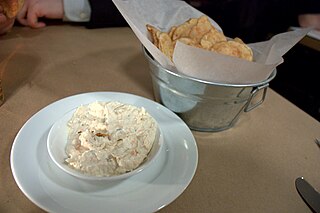
Chilaquiles are a traditional Mexican breakfast dish consisting of corn tortillas cut into quarters and lightly fried.

Chili con carne, meaning "chili with meat", is a spicy stew containing chili peppers, meat, tomatoes, and often pinto beans or kidney beans. Other seasonings may include garlic, onions, and cumin. The dish originated in northern Mexico or southern Texas.

Refried beans is a dish of cooked and mashed beans that is a traditional staple of Mexican and Tex-Mex cuisine, although each cuisine has a different approach when making the dish. Refried beans are also popular in many other Latin American countries. The English "refried beans" is a mistranslation, since the essence of "frijoles refritos" is the reheating and mashing of the beans.

Salsa is a variety of sauces used as condiments for tacos and other Mexican and Mexican-American foods, and as dips for tortilla chips. They may be raw or cooked, and are generally served at room temperature.

Pork and beans is a culinary dish that uses pork and beans as its main ingredients. Numerous variations exist, usually with a more specific name, such as Fabada Asturiana, Olla podrida, or American canned pork and beans.

Chile con queso, sometimes simply called queso, is an appetizer or side dish of melted cheese and chili peppers, typically served in Tex-Mex restaurants as a dip for tortilla chips.

Tuna casserole is a casserole primarily made with pasta or rice and canned tuna, with peas sometimes added. The dish is often topped with potato chips, corn flakes, bread crumbs or canned fried onions. Tuna casserole is a common dish in some parts of the United States, often prepared using only nonperishable pantry ingredients.

Bean salad is a common cold salad composed of various cooked beans – typically green, wax, kidney, and/or lima beans - tossed in a sweet-sour vinaigrette. Variant ingredients include fresh raw onions, bell pepper, and/or other cooked or raw vegetables, such as chickpeas.

Corn chowder is a chowder soup prepared using corn as a primary ingredient. Basic corn chowder is commonly made of corn, onion, celery, milk or cream, and butter. Additional ingredients sometimes used include potatoes or squash, salt pork, fish, seafood and chicken. In the United States, recipes for corn chowder date to at least as early as 1884. Corn chowder is mass-produced as a canned food in the U.S.

Picadillo is a traditional dish in many Latin American countries including Puerto Rico and Cuba as well as the Philippines. It is made with ground meat, tomatoes, and also raisins, olives, and other ingredients that vary by region. It is often served with rice or used as a filling in dishes such as tacos, savory pastries or croquettes. The name comes from the Spanish word picar, meaning "to mince".

Adobada is a preparation for many dishes that are common in Mexican cuisine. Adobada is generally pork marinated in a "red" chili sauce with vinegar and oregano, but it can refer to different types of meat and to marinades closer to al pastor. It is generally served on small, pliable corn maize tortilla along with sautéed vegetables and cheese.

Clam dip is a dipping sauce and condiment prepared with clams, sour cream or cream cheese, and seasonings as primary ingredients. Various additional ingredients can be used. It is usually served chilled, although it is sometimes served hot or at room temperature. It is used as a dip for potato chips, crackers, bread, and crudités. Commercial varieties of clam dip are mass-produced by some companies and marketed to consumers in grocery stores and supermarkets.

French onion dip or California dip is an American dip typically made with a base of sour cream and flavored with minced onion, and usually served with potato chips as chips and dip. It is also served with snack crackers and crudités. It is not French cuisine; it is called "French" because it is made with dehydrated French onion soup mix.

Acquacotta is a hot broth-based bread soup in Italian cuisine that was originally a peasant food. Its preparation and consumption dates back to ancient history, and it originated in the coastal area known as the Maremma in southern Tuscany and northern Lazio. The dish was invented in part as a means to make hardened, stale bread edible. In contemporary times, ingredients can vary, and additional ingredients are sometimes used. Variations of the dish include aquacotta con funghi and aquacotta con peperoni.

Chips and dip is a dish consisting of chips (crisps) served with dips. Chips used include potato chips, tortilla chips, corn chips, bean chips, vegetable chips, pita chips, plantain chips and others. Crackers are also sometimes used, as are crudités, which are whole or sliced raw vegetables. Various types of dips are used to accompany various types of chips. It may be served as a party dish, appetizer, hors d'oeuvre, or snack.

Chili mac is a dish prepared using chili con carne and macaroni as primary ingredients, which is often topped or intermingled with cheese. Some versions are made using prepared or homemade macaroni and cheese. It is a common dish in the cuisine of the Midwestern United States, and is also popular in other areas of the United States.

Corn stew is a stew prepared with corn (maize) as a primary ingredient. Many variations exist in ingredient usage and in methods of preparation. Corn stew is a dish in several cuisines of the world. Mazamorra is an historically old corn stew dish in South America that is prepared using simple ingredients, and is a dish in several other cuisines.

Tamale pie is a pie and casserole dish in the cuisine of the Southwestern United States. It is prepared with a cornmeal crust and ingredients typically used in tamales. It has been described as a comfort food. The dish, invented sometime in the early 1900s in the United States, may have originated in Texas, and its first known published recipe dates to 1911.































